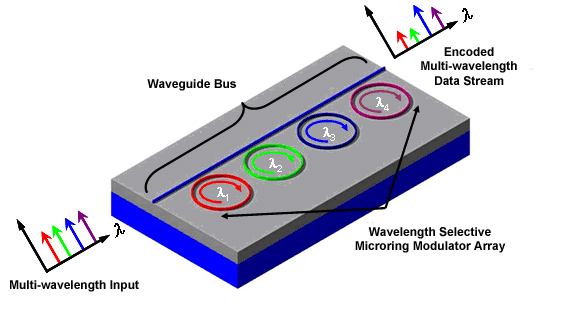The success of code division multiple access techniques in providing secure and spectrally efficient communication can be readily seen in their deployment in wireless networks around the globe. The optical analog, OCDMA, has the potential to increase the capacity and security of existing wavelength division multiple access (WDMA) networks, but these improvements come at the expense of hardware complexity and cost. Fortunately, CMOS scaling, driven by “Moore’s Law,” has allowed significant advancements in microelectronic integrated circuit technology. In addition, high index contrast SOI optical waveguides have demonstrated their potential for enabling low loss high-density photonic integrated circuits on silicon. Therefore, the SOI platform provides a viable solution to the hardware challenges and is an ideal candidate for realizing the OCDMA encoder technology.
The chip level architecture of the OCDMA encoder is shown in Figure 1. The waveguide bus distributes a multi-wavelength input to the modulator array. A high-Q microring resonator, operating as an optical intensity modulator, is the basic building block for the encoder. Each modulator encodes its resonant wavelength without introducing crosstalk to the non-resonant wavelengths. The encoded data stream is multiplexed back onto the waveguide bus for transmission into the fiber-optic network. Due to their simple geometry and small form factor, high-Q microring resonators are ideally suited for very large scale integration with CMOS microelectronics.

Figure 1: Schematic diagram of a monolithically integrated OCDMA Encoder on SOI. A multi-wavelength source feeds a waveguide bus that is periodically loaded with an array of wavelength selective microring modulators. Each modulator encodes a specific wavelength without introducing crosstalk to the non-resonant wavelengths. The encoded multi-wavelength data stream is recombined in the waveguide bus for transmission. |
